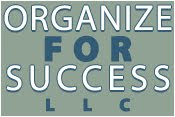When you look around your workspace, whether it is a cubicle, automobile, corner office or table in a coffeeshop, what do you see? Does the clutter overwhelm you? Can you quickly find what you need? Is there a process set for how your work flows throughout?
If it is not helping achieve your goals, take time now to make your space a tool in your productivity toolbox.
- Take time to review the contents of your workspace. Retain only what is accurate, applicable, useful or bringing you joy... It is easier to find what is needed when there is less to look through. As you are editing, consider what can be easily found online as needed. There is no need to clutter your space with what can be found quickly with a simple online search. Further, always take into account any legal ramifications.
- As you purge accumulated excess, be strategic. What can be recycled? What must be shredded? Particularly for technology, what can be sold via NextWorth or Gazelle and what could you recycle? Speaking of tech tools, what functionality can be consolidated so you have fewer devices?
- Assign homes to what will be kept, storing items in zones closest to where they will be used. Remember the quote "a place for everything and everything in its place" to stay organized. When you know where something goes, it is easier to put it away after you've used it and find it when you need it again later. Also, keep "like with like" in mind as you assign homes, grouping like items together so they can be found at the same time.
- As if you were considering a real estate purchase, when organizing your workspace, think "location, location, location" and separate "active" items from those considered "archive". Things you are using currently or use more frequently should be in the prime real estate closest to where you are situated most often; then, items used less frequently get positioned further out.
- Move shared files and tools into a common space for team members to easily access.
- Determine if your personality is more "out of sight is out of mind" or "visual clutter paralyzes" so you can choose appropriate storage tools, and contain what you retain in the best storage tools to create applicable limits, whether files, bins, baskets, drawers, boxes or cabinets. A great example is how I use document boxes to keep related items together while their project is active and being addressed regularly, but you have to utilize whichever containers best meet your specific needs.
- Utilize labels and color to enhance the effectiveness of organizational solutions. Labels allow you to quickly determine what is housed where within your space; likewise, different colors can group together similar items as well as drive desired behaviors. There is no "right" or "wrong" verbiage to use when labeling, but balance carefully between generic and specific labels to enhance effectiveness. For example, "miscellaneous" creates a black hole to contain just about anything. If you struggle to determine in which file something should be kept, how will you ever be able to find those contents when you need to retrieve them later? It can be an art form to make sure you have enough files for everything you need to keep while not having so many files that you potentially create duplicates or struggle to file anything away.
- Remember "horizontal is hidden; vertical is visible"; I recommend using file holders that will not bury one folder under another and hanging an inbox by your door so those delivering you items won't lay them in your chair or atop what's on your desk.
- Finally, utilize all the walls and backs of doors in your workspace. These areas of your space provide valuable square footage that can be wasted and go unused but will help to give you more options for storage and easily accessing necessary items.
With what do you struggle in your workspace? What steps can you take to make a more organized workspace, which will empower more efficient workflow processes?
Subscribe to:
Post Comments (Atom)


No comments:
Post a Comment